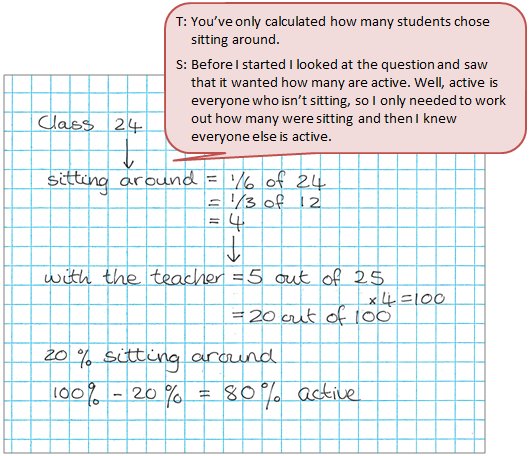The purpose of this activity is to engage students in using fractions and percentages to solve a problem.
This activity assumes the students have experience in the following areas:
- Expressing percentages as a fraction out of 100.
- Finding equivalent fractions.
- Using fractions to represent a part-whole relationship (proportion).
- Finding a fraction or percentage of a whole number amount.
The problem is sufficiently open ended to allow the students freedom of choice in their approach. It may be scaffolded with guidance that leads to a solution, and/or the students might be given the opportunity to solve the problem independently.
The example responses at the end of the resource give an indication of the kind of response to expect from students who approach the problem in particular ways.

A group of students have been asked to write a report on the use of the school playground at lunchtime.
They asked everyone in their class what their preferred activity was. One half of the students said soccer, one quarter said the adventure playground, one sixth said sitting around and the remainder said playing tag. There are 24 students in the class. They then realised the teacher should be included. She said she liked to sit around as well.
What percentage of the whole class (teacher included) can the group say are active at lunch time?
The following prompts illustrate how this activity can be structured around the phases of the Mathematics Investigation Cycle.
Make sense
Introduce the problem. Allow students time to read it and discuss in pairs or small groups.
- Do I understand the situation and the information? (Students may need support to understand the situation, especially that the fractions stated are with a class of 24 students after which the teacher is added.)
- What are the important numbers in the problem? (Do students recognise that finding fractions of an amount is required. Do they understand the meaning of unit fractions as equal parts?)
- What will my solution look like? (The solution will state the percentage of the class who prefer active pursuits at lunchtime. It will also show how the answer was obtained.)
Plan approach
Discuss ideas about how to solve the problem. Emphasise that, in the planning phase, you want students to say how they would solve the problem, not to actually solve it.
- What math skills will I need? (Students should recognise that they will need to find fractions of amounts, add fractions, and convert fraction to percentages.)
- How will I organise my working out, so I answer the problem in a systematic way, and not miss anything?
- What representations will be helpful? A diagram? Equations? Acting out?
- What tools (digital or physical) could help my investigation? (A scientific calculator is not essential but will ease the calculation burden.)
Take action
Allow students time to work through their strategy and find a solution to the problem.
- Have I shown my workings in a systematic way?
- Have I used all the information in the problem?
- Do my operations make sense? Do they match the conditions of the problem?
- Did I notice any relationships among the numbers that could be helpful?
- Did my diagrams and acting out match my calculations?
- Does my answer seem correct? Does it seem reasonable?
Convince yourself and others
Allow students time to check their answers and then either have them pair share with other groups or ask for volunteers to share their solution with the class.
- What is the solution? Does it give the percentage of active people?
- Is my working clear for someone else to follow?
- Do I justify each step of my working? How?
- Could I have solved the problem in a more efficient way? How?
- What maths have I used?
- How might I use what I learned on this problem to solve other problems?
Examples of work
Work sample 1
The student finds the number of students doing each activity, by finding fractions of a whole number. They allow for the teachers and express the fraction of ‘active’ people as equivalent fractions and percentage.
Click on the image to enlarge it. Click again to close.
Work sample 2
The student draws a 6 x 4 array to represent the students in the class and partitions the array into parts matching each fraction. After allowing for the teacher, they draw four arrays that measure 5 x 5 to model a percentage. Using a combination of diagrams and calculations they find the correct percentage.


